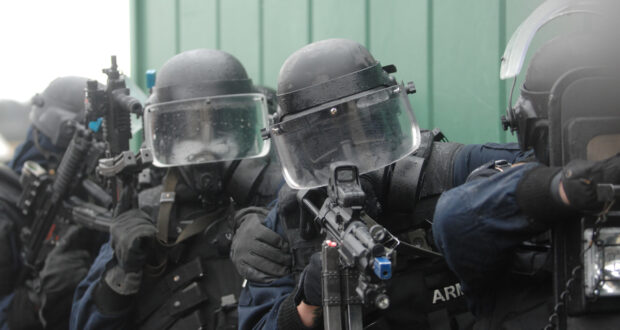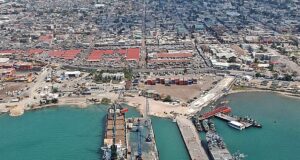1 January, 2021
By Ataa Dabour – Research Assistant
In the late 1980s, Fourth Generation Warfare (4GW) theorists began to recognize a shift in the shape of conflicts. The war has evolved. It has become hybrid and asymmetrical, explains the Israeli military historian Martin van Crefeld in his Transformation of War, or molecular, according to the authors of Citoyen-Soldat 2.0, Bernard Wicht and Alain Baeriswyl.
In the context of international conflicts, ‘civilians’ are generally defined by International Humanitarian Law as individuals who are not members of the armed forces of a party to the conflict or any other organised armed forces, groups and units that are under the authority of a commander responsible for the conduct of his subordinates, and are not participating in levée en masse – i.e., spontaneous open armed resistance against an advancing force.
This definition is settled in the context of international conflicts, but there have been proposals to amend the Geneva Convention to restrict the meaning of civilian in the context of non-international armed conflict to also exclude anyone who is a member of an armed group regardless of whose authority they operate under. However, at present, the definition of civilian remains the same for both types of conflict.
As such, non-state actors such as violent armed groups or organizations, terrorists, and cyberterrorists are currently defined as civilians, and will remain so for the foreseeable future. The challenge, therefore, is to tailor the response that such actors require. As the actors, the theatre, the means, and the strategy of response to war have changed, we need to shift our mentality and rethink our defense and security response to succeed in ensuring security and protecting people from threats caused mainly by civilians.
Security Threats caused by Civilians
Terrorism
Terrorist attacks are increasing around the world. It is or course appropriate to note that it is warzones in the Middle East and Asia that have borne the brunt of such violence. However, the West has not escaped. In recent years, the United States and several European countries have faced terrorist attacks, with both Islamic militants and far-right groups inflicting serious casualties.
The list of attacks is too numerous to cite in full, but major incidents stand out. One of the most serious incidents of recent years was the coordinated bombings and mass shootings that erupted at several venues across Paris on November 13th, 2015. Some 130 people were massacred – the greatest loss of life to violence in France since World War Two – and scores more were injured: an “act of war”, claimed the former French President, François Hollande.
The nine perpetrators identified – who themselves were part of a larger terrorist cell based in Brussels – were from a variety of backgrounds, including French and Belgium nationals who had traveled to the Middle East and obtained combat experience, as well as individuals originating from the region. As is generally the case with terrorists, all were civilians.
The UK has also witnessed serious incidents, including the 2016 attack on London Bridge which resulted in nine deaths. Again, the perpetrators had mixed backgrounds, one being of Pakistani origin but raised in London, one a failed asylum seeker from North Africa, and the third a dual Moroccan and Italian national. None were current members of any state-run armed forces.
Attacks by right-wing extremists are similarly proliferating. The individual who attacked the Christchurch Mosque in 2019, killing 51 people, was a white supremacist, alt-right conspiracy theorist, and former personal trainer who is thought to have become radicalized during his travels in Europe. His military background was non-existent, but he was still responsible for the single deadliest attack on citizens of the country since 1943.
In the US, one of the most notable recent attacks linked to the far right was committed in 2019 by a 21-year old man who killed 23 Latinos in El Paso, Texas. Europe has also not been spared, with an attack on a German synagogue by a neo-Nazi last year killing two. The UK’s Prevent counter-radicalization program has seen a surge in referrals of suspected far-right extremists in recent years.
Non-state armed groups
Civilian-led violence is not limited to traditional terrorism, with non-state armed groups proliferating in North and South America, Africa, the Middle East, and Asia. In the Western Hemisphere, much of this violence is linked to drug trafficking. In Mexico, it is estimated that there were 34,582 homicides in 2019 alone. In Columbia, serious violence persists in Narino, Cauca, Arauca, which are regions contested by drug traffickers, criminal groups, and dissidents of the demobilized FARC guerrillas. In 2019, there were more than 10,000 homicides and 230 activists killed.
Violent non-state actors also continue to create chaos across the Middle East. The Houthi of Yemen is one of the most sophisticated groups, having waged war since 2014 against a Saudi-led coalition for control of Yemen. The Houthi’s use of technology represents an increasing trend of weapons systems previously limited to states falling into the possession of non-state groups, with drones, ballistic missiles, and anti-ship missiles having all been deployed. Drones have also been fielded by Hezbollah and ISIS, with the former group also having a sophisticated arsenal of missiles and rockets, and the latter having deployed crude chemical weapons.
In Africa, the ISIS-affiliated Boko Haram continues to wage a brutal insurrection in northeastern Nigeria and nearby territories. It is thought that tens of thousands have died in the conflict since 2009. Utilizing tactics including kidnapping and suicide bombing, the group is currently on the back foot but remains a serious threat.
While by no means comprehensive, the above serves to illustrate the range of forms and capabilities demonstrated by non-state armed groups across the globe. And yet while such violence is a source of immense instability and human suffering, conflict is now spreading into new realms.
Cyberterrorism
As cyberspace is becoming a new battlefield, terrorist organizations are adapting their means to this new reality. Although no firm definition of cyberterrorism exits, it can be strongly argued that two fundamental features distinguish cyberterrorism from cybercrime: cyberterrorism cause terror and a sense of insecurity by causing extensive disturbances, and tends not to have a financial motivation. It is distinguished from cyberwar by being the province of non-state actors who, as is the case with terrorism in general, use or the threat of infliction of harm for political or ideological reasons. Similarly, cyberterrorism can use the same methods as cybercrime and cyberwar, but with different actors and underlying motives.
To an extent, cyberterrorism remains a theoretical threat. The most severe cyberattacks have so far largely been the responsibility of either states or conventional criminals seeking profit. Notably, the spring 2007 cyberattacks in Estonia were certainly politically motivated – the relocation of a statue of a Soviet soldier being the immediate trigger – but it seems likely that the hackers were working for or operating adjacent to the Russian state. The spring 2017 WannaCry ransomware attack sought to extort its victims for money.
Nevertheless, a number of incidents have occurred that point to future challenges – particularly as ever-more devices are linked to the internet and vulnerable to disruption. Perhaps most notably, in 2012, hackers calling themselves the ‘Cutting Sword of Justice’ launched an attack on the Saudi oil company Aramco. 35,000 computers were either partially wiped or destroyed, with the group citing the company’s support for the Saudi royal family as the motivation for the hack.
It is also fair to say that cyberterrorism can operate in a supporting role rather than be a direct attack. Notably, in September 2016, Kosovo native Ardit Ferizi was sentenced to 20 years in prison for hacking information on 1,300 US government and military personnel and passing it to ISIS.
Facing the Fourth Generation Warfare through a New Security Response Model
War evolves in response to changes in the world’s social, political, and economic conditions as well as to the introduction of new technologies. The evolution of war in the twentieth century is traditionally divided into four generations:
- Conventional Wars
- Cold War
- Brushfire Wars (Wars of Decolonization)
- Hybrid /New Wars
Today we are experiencing the fourth-generation warfare (4GW) – a term used by military thinkers to describe the new face of conflict at the end of the 20th century – described also as new, asymmetrical, molecular, or hybrid war as proposed by the American military analyst Frank Hoffman in 2007. New wars are similar to wars before states had a monopoly on the use of violence, explains the German politician Herfried Muenkler. What mainly characterizes fourth generation warfare is:
- Forces of different nature – national armed force vs unconventional and irregular forces, or spoilers, as qualified by General Ruppert Smith in his Utility of Force
- War from weak to strong, where the weakest units win
- Differences of objectives
- Low intensity vs. high intensity
- Urbanization and globalization
- Technology-driven
All the given examples in our section Security Threats caused by Civilians emphasize these characteristics and prove that although the state has almost always a greater superiority over the non-state opponents in what we call “combat power” – technology, weapons, techniques, training, etc. – this new method of warfare poses a difficult challenge to States seeking to protecting civilians and ensure security. The nation’s existing national strategies, warfighting concepts, and force structures are ill-suited for this emerging blend of warfare, according to Franck G. Hoffmann, who serves at the American National Defense University.
This warfare evolution reveals that the future cannot be captured with a single approach to defense planning. The more likely combination of warfare modes and actors requires modification and expansion of its conventional mindset, and necessitates some innovative thinking. Any force prepared to address hybrid threats need to recognize or quickly adapt to the unknown, explains David G. Gombert in his Counterinsurgency Study, and use an agile strategic approach that relies on a wide array of capabilities.
According to Franck G. Hoffman, success in hybrid wars also requires small unit leaders with decision-making skills and tactical cunning to respond to the unknown—and the equipment sets to react or adapt faster than our foe. In Sweden for example, civil defense is a key part of the defense in general, since the civil and military sector has now the same enemy. The civil defense is composed of people who are armed and continuously well-trained in the use of force, de-escalation of tensions methods, as well as emergency care. Bernard Wicht and Alain Baeriswyl propose to equip all civilians with weapons and to add medical kits in different and several parts of cities to ensure a quicker response to threats.
More complete, General Steven C. Williamson proposes in his Strategy research project a strategy to address internal and external new threats. According to him, the United States and all countries must:
- Review and adjust their national strategies, warfighting concepts, and force structures.
- Develop enhanced interagency and multinational capabilities and coordination; dynamic public diplomacy and statecraft; partnership building capacity; superior expeditionary power projection;
- Realign their global defense structure and positioning;
- Have more adaptive planning and a reconsideration of operational warfighting art;
- Enhance training and educational programs; more agile, professional multi-purpose forces; and a renewed appreciation of and capacity to wage irregular warfare;
- Be able to adaptively and effectively combine these capabilities to prevail in the hybrid conflicts that will dominate the near to mid-term;
- Look internally to expand their ability to address the non-military aspects of conflict
- Improve the interagency planning and integration process by coordinating military efforts with appropriate civilian agencies and by engaging expertise in the private sector, including non-governmental organizations and academia.
To adapt our security response to hybrid wars and to ensure the safety of our citizens, it appears necessary for many strategists to unify civil and military counterinsurgency, to give a greater role to civilians in defense and security fields, to work in close collaboration with different sectors and combining capabilities, as well as to choose technologically driven solutions. Shared responsibility, collaboration, adaptability, resilience, and innovative thinking are the most fundamental security needs.
Image: Irish Army Ranger Wing operators during counter-terrorism training exercise (Source: Irish Defence Force via CC BY 2.0)
 Human Security Centre Human Rights and International Security Research
Human Security Centre Human Rights and International Security Research




